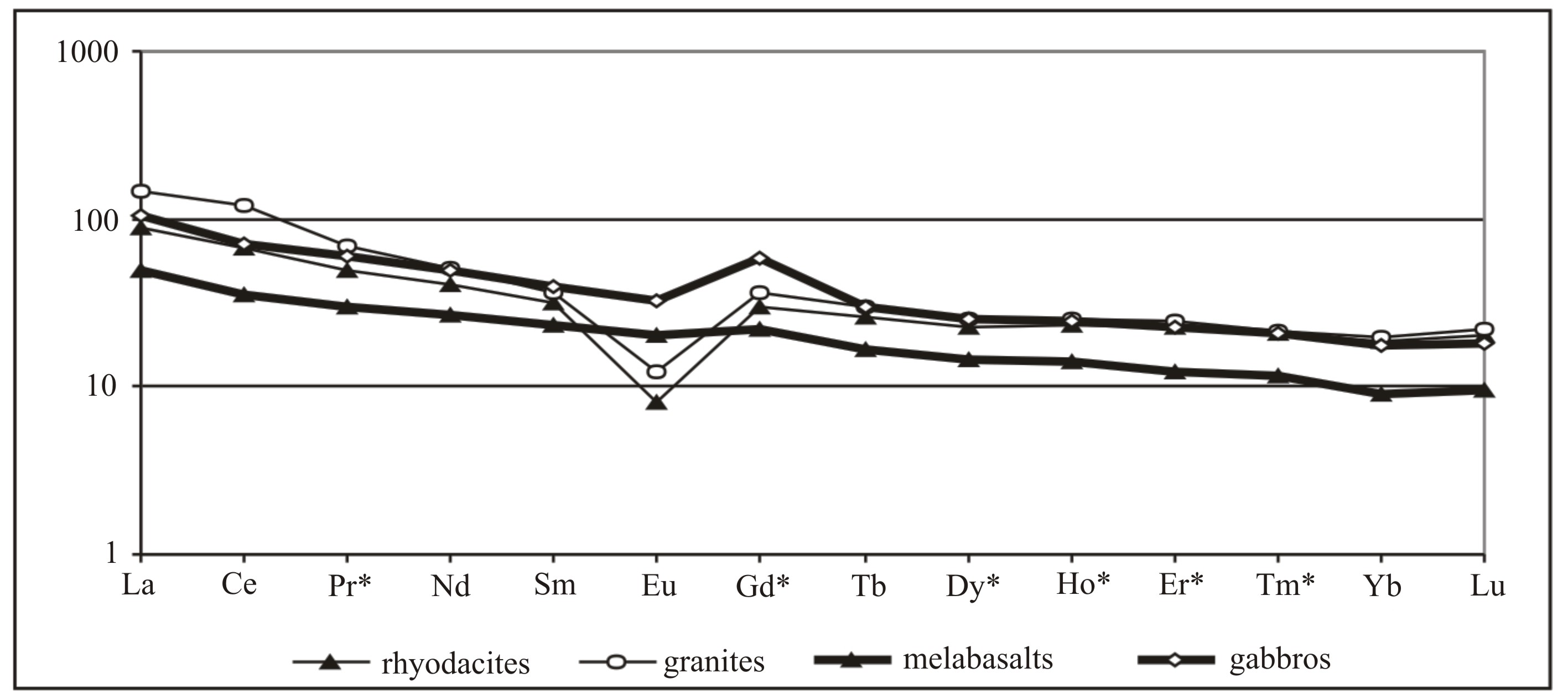|
GRANITOIDS OF THE POLAR URALS CONTRASTING FORMATION
Geological Institute of Komi Research Centre, UrB RAS, Syktyvkar, Russia, petr@geo.komisc.ru
The contrasting granitoid-basite associations of hypabyssal and subvolcanic facies formed in conditions of the Andian type active continental margins are widely developed on the western slope of the Polar Urals (Golubeva 2003; Golubeva and Ilalova 2003). The large two-phase hypabyssal gabbro-granite Lemvinskiy pluton is particularly prominent. Gabbroids and granites formed subsequently during different phases of introduction. The contact is clearly intrusive with occurrence of eruptive breccias, where granite appears to be matrix, and fragmentary part is represented by basites. Numerous dykes and veins of granites are observed along the extension of the whole section in view. The massif morphologically represents plate-like intrusion about 40 km long, dipping at ~450 to the north-east that belongs to the fault, being parallel to the Main Urals Thrust. The gabbro is composed by diopside (10-30%), hornfels (10-20 %), eustatite (0-10%), plagioclase (60-70%), biotite (0-5%0 and characterized by poikilophytic and ophitic textures. By petrochemical characteristics, basites of the Lemvinskiy massif are highly aluminous (al' = 1.04; Al2O3 = 11.73-24.74%) and referred to the potassium-sodium subalkaline series (Na2O/K2O = 1.5). Granite has hypidiomorphic- and irregular-grained texture that transforms into porphyritic one at the endocontacts, and either micropigmatite or granophyric texture – in the near roof apical areas. The predominant mineral is alkaline feldspar (45-50%), the rest volume of the rock is composed by quartz (32-37%), plagioclase (15-25%), also biotite (1-2%) and green lepidomelane (to 5-7%). The specific mineral is fluorite (to 1%). Albite intergrowths are observed as a rule, in K-feldspar, their quantity reaching 50% in some cases. Mesoperthites are originally “visiting card” of the present granites. By petrochemical peculiarities (excess of silica and alkali at very low contents of alkaline-earth elements, i.e. magnesium, calcium and strontium), the described rocks are typical A-granites (Makhlaev 1996). It should be noted that participation in contrast formations that can present volcano-plutonic series and explosive products due to high extent of melt overheat is specific of A-granites. Rhyolites and intrusive explosive formations are spatially and petrogenetically associated with the Lemvinskiy granitoids. Rhyolite composes the extensive subintrusions and dykes. They are characterized by aphyric and porphyry structures, fluidal, banded, discontinuously banded ignimbrite-like textures, high contents of SiO2 (to 81.62%) and K2O (to 10%). Fluidized-explosive coarsely fragmentary clastites (tuffisites and ignimbrites) contain well rounded clasts that lead to erroneous interpretation of the present rocks (Golubeva 2003). Many researchers take them for the Ordovician psephites, considering only ideally rounded clast contours of granite composition. The tuffisites form blanket bodies of clothing in the eastern hanging wall of the granite massif and diatreme. Ignimbrites like relatively thick dykes and veins form in the shale enclosing rock and tuffisite bodies. The subvolcanic Pogureiskaya rhyodacite-melabasalt contrasting association that occurs to the north of the described pluton represents the fracture subvolcanic intrusion, forming the plate-like body elongated for ~2 km from the north-west to south-east. The basites of the association are differentiated from picro- to melabasalts (38.96-5.68% SiO2), moderately aluminous (al' = 0.78; Al2O3 = 15.17-19.51) and belong to the subalkaline series of the potassium-sodium type. They have cryptocrystalline, microporphyry, massive and sometimes amygdaloidal structures. Lavabreccias of rhyodacites are represented as lens-like bodies that are localized in central part of basite intrusion. Fluidal structures and false bedding caused by alternation of layers with clasts of acid migmatites being of aleuro-sand, gravel and pebbled dimensionality. Matrix is composed by microfragmental breccia and fragmented lava. The fragments of main composition being the captured microxenoliths of host basites often occur that indicates homodromal character of contrasting intrusion formation. By the petrochemical characteristics, rhyodacites belong to the potassium-sodium series (68.52-70.57% SiO2). The intrusive fluidal-explosive formations of acid composition are also spatially associated with this subintrusion (Golubeva, Makhlaev 2005). Thus, dacites of gabbro-norite and rhyodacite-melabasalt contrasting associations are identical in fact by the petrochemical and geochemical characteristics (Fig. 1) that testifies to the single magma generating source of those and other basic rocks, their common history, specificity of intrusive body formation as well as to the similar geodynamic setting during their formation.
Fig. 1. Distribution of Rrare Earth Elements that are normalized to chondrites in the contrasting associations: gabbro-granite and melabasalt-rhyodacite (Polar Urals). Acid magmatites of the contrasting intrusions significantly differ by main rock-forming elements that is explained by various composition of initial substrates subjected to melting due to thermal effect of basalt melt and being, additionally, at different depth levels. In one case, the melting occurs in the granitized (granite-gneiss) substrate that results in A-granite formation of the Lemvinskiy pluton, and in the other one, due to the melting the paraschists, more melanocratic melts appear that form rhyodacites of the Pogureiskaya subintrusion.
References Golubeva I.I. (2003) Magmatogenic fluidal-explosive formations of North Urals. Ekaterinburg, 137p. Golubeva I.I. (2003) Molyudvozhskaya suite and problem of determining the lower structural floor of the Lemvinskaya zone (North Urals) // Volcanism and geodynamics. Ekaterinburg, P.624-625. Golubeva I.I., Ilalova E.M. (2003) Gabbros of the Lemvinskiy massif (North Urals) //Petrology and Mineralogy of North Urals and Timan. Syktyvkar, P.38-53 (Work collections of Geological Institute, Komi Research Centre, Urals Branch RAS, issue 113). Golubeva I.I., Makhlaev L.V. (2005). Conglomerates and magmatogenic pseudoconglomerates. Ekaterinburg. 178p. Makhlaev L.V. (1996) Granitoids of the northern Central Urals uplift. Polar and Pre-Polar Urals. Ekaterinburg. 150p.
|
